When you think about motorcycle history, consider the engineering challenges that have driven its evolution. From the intricacies of tuning V-Twin engines to managing heat and meeting emissions standards, each obstacle has sparked innovative solutions that shaped design and performance. You might find it intriguing how advancements like lightweight materials and smart technology emerged from these very challenges. As the industry continues to adapt, it raises questions about what lies ahead. What new hurdles will engineers face, and how will they redefine the motorcycle experience?
Key Takeaways
- The unique V-Twin engine configuration complicates tuning and requires innovative solutions for performance and heat management.
- Effective thermal management is crucial to prevent overheating and maintain optimal engine performance in varying riding conditions.
- Compliance with stricter emissions regulations pushes manufacturers to develop technologies that balance power output with environmental responsibility.
- The use of lightweight materials challenges engineers to maintain strength while reducing weight for improved speed and efficiency.
Early Innovations in Ducati Design
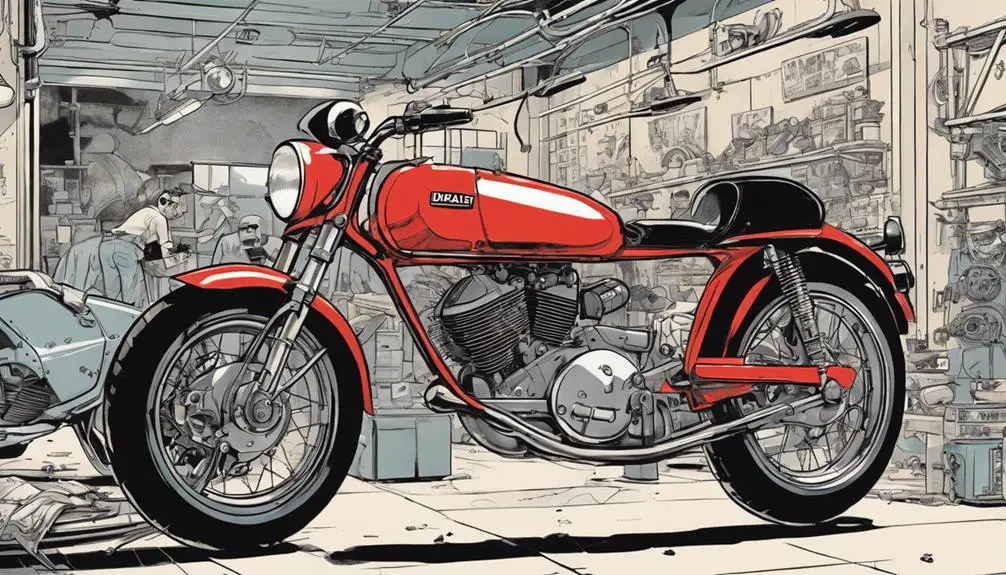
When you explore Ducati's early innovations, you'll discover how their groundbreaking designs set new standards in motorcycle engineering. From the moment they entered the market, Ducati pushed boundaries, blending performance with style. Their focus on lightweight frames and powerful engines transformed how riders experienced freedom on two wheels.
Ducati embraced the idea of speed not just as a thrill but as a means of liberation. The introduction of the narrow-angle V-twin engine showcased their commitment to power and agility. You can feel the exhilarating rush as you ride a Ducati, each twist of the throttle urging you to break free from the mundane.
In those early years, Ducati also prioritized aesthetic appeal. You'll find that their sleek lines and bold colors didn't just make a statement; they embodied a spirit of adventure. You weren't just riding a motorcycle; you were embracing a lifestyle that celebrated individuality and the open road.
Ducati's innovations ignited a revolution, inspiring riders to seek liberation through speed, style, and engineering excellence. It's this very essence that continues to resonate with enthusiasts today, encouraging you to experience the thrill of riding like never before.
The Desmodromic Valve System
The Desmodromic Valve System is a revolutionary engineering feat that sets Ducati apart, ensuring precise control over valve timing and performance. Unlike traditional systems that rely on springs to close the valves, this innovative design uses dual actuators—one to open and another to close. This means you gain absolute control over every aspect of valve operation, allowing for higher revs and improved efficiency.
Imagine the freedom you'll feel while riding a Ducati equipped with this system. You're not just experiencing power; you're tapping into a finely-tuned machine that responds instantaneously to your commands. The Desmodromic setup minimizes the risk of valve float at high speeds, which translates to a smoother ride and enhanced reliability.
As a rider, you crave that connection with your motorcycle, and this system amplifies that bond. You can push the limits without worrying about performance drops. Embrace the thrill of the open road knowing your bike is engineered for liberation, precision, and excitement.
The Desmodromic Valve System isn't just a technical marvel; it's an affirmation of Ducati's commitment to delivering an unparalleled riding experience.
Challenges of V-Twin Engine Development
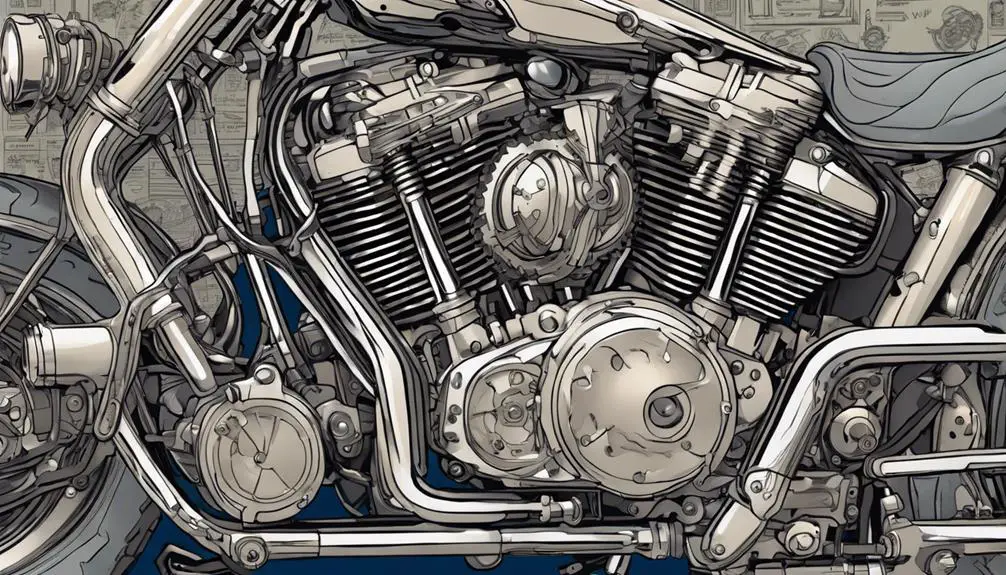
Building on the precision of the Desmodromic Valve System, developing V-Twin engines presents unique challenges that engineers must navigate to maximize performance and reliability. You'll find that these engines, with their distinct configuration, can be tricky to tune. Their design emphasizes torque, but achieving that without compromising horsepower requires a delicate balance.
One major challenge lies in heat management. V-Twin engines generate significant heat, and if it isn't effectively dissipated, you'll face issues like reduced performance and engine failure. Engineers often experiment with cooling systems, seeking innovative solutions that keep temperatures in check while maintaining a sleek design.
Another hurdle is the complexity of vibration. The inherent design of V-Twins leads to unique vibration patterns that can affect comfort and handling. You want a ride that feels smooth and liberating, so engineers must focus on dampening these vibrations without adding unnecessary weight.
Lastly, emissions standards are tighter than ever. Striking a balance between power output and environmental responsibility means engineers must think outside the box, ensuring that your ride not only thrills but also meets modern regulations. Embracing these challenges, engineers push the boundaries of what V-Twin engines can achieve.
Advancements in Lightweight Materials
When you think about motorcycle performance, lightweight materials play an essential role in enhancing dynamics.
By reducing weight, these materials improve acceleration and handling, making your ride more enjoyable.
Understanding their benefits helps you appreciate the engineering advancements that have shaped modern motorcycles.
Benefits of Lightweight Materials
Advancements in lightweight materials have revolutionized motorcycle design, making bikes faster and more fuel-efficient. By using materials like carbon fiber, titanium, and advanced aluminum alloys, manufacturers are crafting machines that shed excess weight without sacrificing strength. This means you get the thrill of the ride while enjoying enhanced maneuverability and responsiveness.
You'll feel the difference as you zip through turns with ease, experiencing a sense of freedom that's hard to match. Lightweight materials also contribute to improved acceleration, allowing you to release the full potential of your motorcycle.
Moreover, these advancements increase fuel efficiency, which translates to longer rides on less fuel. Imagine the liberation of exploring vast roads without constantly worrying about refueling.
In addition to performance, the use of lightweight materials often leads to a reduction in the overall environmental impact of motorcycles. You're not just riding a bike; you're embracing a lifestyle that values innovation and sustainability.
As you enjoy your next ride, remember that lightweight materials are more than just engineering feats—they're your ticket to freedom on two wheels.
Impact on Performance Dynamics
Lightweight materials greatly enhance your motorcycle's performance dynamics, allowing for quicker acceleration and sharper handling. When you shed excess weight, you're not just improving speed; you're releasing the very essence of your ride.
Modern materials like carbon fiber, aluminum alloys, and advanced composites reduce mass while maintaining strength, giving you more control and responsiveness on the road.
Imagine zipping through corners with effortless precision, feeling the bike respond instantly to your every input. Acceleration becomes a thrill as your machine lunges forward, unhindered by unnecessary bulk. With less weight to manage, the suspension and braking systems also perform better, offering you a ride that feels both agile and stable.
This shift towards lightweight engineering changes the game for performance enthusiasts. You can experience the raw power of your bike without the constraints of heavy components.
Embracing these advancements means you're not just riding; you're fully experiencing the freedom and exhilaration that comes with every twist of the throttle. So, gear up and get ready to release your motorcycle's potential, because with lightweight materials, the road is yours to conquer!
Managing Heat and Performance
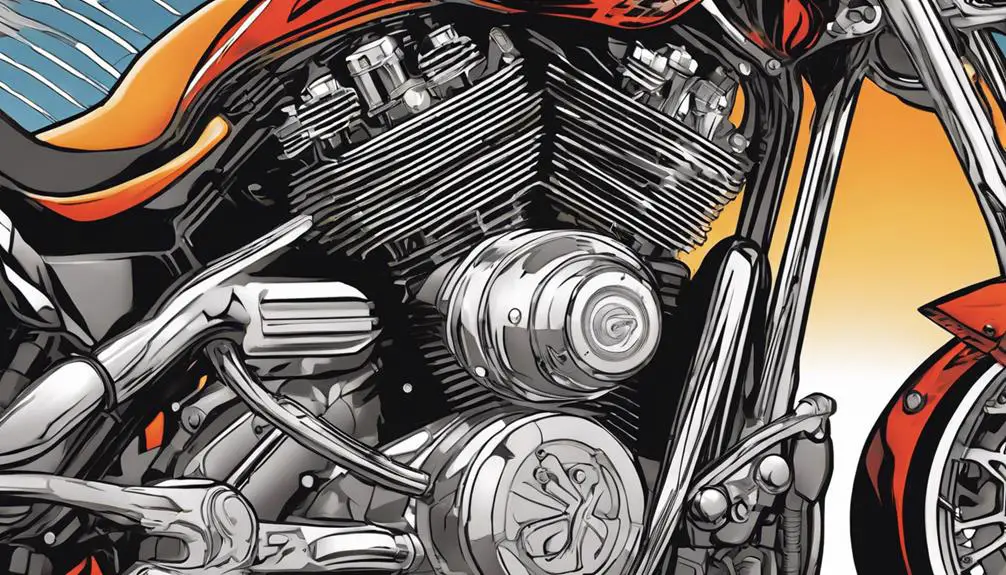
When you think about motorcycle performance, managing heat is essential.
Innovations in engine cooling, exhaust system design, and thermal management solutions all play a key role in keeping your ride efficient and powerful.
Let's explore how these engineering advancements help maintain ideal performance on the road.
Engine Cooling Innovations
Innovative engine cooling systems have transformed how motorcycles manage heat, enhancing both performance and rider comfort.
You might've noticed how modern bikes incorporate advanced cooling technologies, allowing for longer rides without the fear of overheating. Liquid cooling systems, for instance, use coolant to efficiently dissipate heat away from the engine, keeping temperatures stable and performance ideal.
You're also likely aware of the benefits of air-cooled engines, which rely on airflow to maintain coolness. However, recent innovations have taken this concept further, utilizing strategically placed vents and fins that enhance airflow even at lower speeds.
These advancements not only improve engine longevity but also give you the freedom to push your bike to its limits without worry. Enhanced cooling systems allow you to focus on the ride, not the heat.
Moreover, some manufacturers are experimenting with heat-resistant materials and coatings, designed to minimize heat transfer to other components. This means you can enjoy a smoother ride, allowing for better handling and control.
Embrace these innovations; they're paving the way for a new era of motorcycle performance that liberates you from the constraints of heat management.
Exhaust System Design
Effective exhaust system design plays an essential role in managing heat and optimizing performance, ensuring your motorcycle runs smoothly and efficiently. A well-engineered exhaust system not only expels exhaust gases but also minimizes back pressure, allowing your engine to breathe freely. This freedom translates to enhanced horsepower and torque, giving you the thrilling ride you crave.
When you consider exhaust materials, lightweight options like titanium or stainless steel can reduce overall weight without sacrificing durability. These materials withstand high temperatures, preventing heat buildup that could damage your engine. Tailoring the exhaust's shape and length also helps in tuning the sound and performance, creating a unique experience tailored just for you.
Additionally, incorporating features like catalytic converters and mufflers can help maintain compliance with environmental regulations while still providing that exhilarating sound you love. An optimized exhaust system isn't just about raw power; it's about harnessing that energy to release your motorcycle's full potential.
In the end, designing an effective exhaust system is about achieving balance—maximizing your ride's performance while managing heat effectively. Embrace the freedom of the open road with a system that enhances your motorcycle experience.
Thermal Management Solutions
Managing heat in motorcycle engines requires strategic thermal management solutions that optimize performance and prolong engine life. By understanding how heat impacts your ride, you can take proactive steps to enhance your machine's efficiency.
Cooling systems, for instance, play an essential role. Whether you opt for air-cooling or liquid-cooling, each system has its strengths. Air-cooled engines are lighter and simpler, while liquid-cooled engines excel in heat dissipation, particularly during long rides.
Insulation materials also matter. They help keep the heat where it belongs—inside the engine—while minimizing heat transfer to sensitive components. You can also explore advanced technologies like oil coolers and heat exchangers to regulate temperatures effectively, ensuring your bike performs at its best.
Furthermore, consider the design of your exhaust system. A well-designed exhaust not only enhances performance but also helps manage heat, reducing the risk of overheating.
Ultimately, embracing these thermal management solutions allows you to release the full potential of your motorcycle. With the right strategies in place, you can enjoy a powerful, reliable ride that embodies the spirit of freedom on the open road.
Emissions Regulations and Compliance
Emissions regulations have greatly impacted motorcycle design and performance, pushing manufacturers to comply with stricter environmental standards. You might feel a sense of freedom when you ride, but those regulations are essential for ensuring the air you breathe stays clean.
As a rider, you benefit from advancements in technology driven by these compliance demands. Manufacturers have turned to innovative solutions like electronic fuel injection and catalytic converters to reduce harmful emissions while maintaining the thrill of the ride.
You'll notice how these changes enhance efficiency and performance, allowing you to enjoy longer rides with fewer stops at the pump. However, these regulations also challenge manufacturers to balance power and eco-friendliness. They're constantly tweaking engine designs and exhaust systems to meet the latest standards without sacrificing your riding experience.
As you rev your engine, remember that these developments reflect a commitment to both your freedom on the road and our collective responsibility to the environment. Embracing these changes can lead to a more sustainable future, ensuring that you and future generations can enjoy the open road without compromising on air quality.
The Impact of Racing Technology
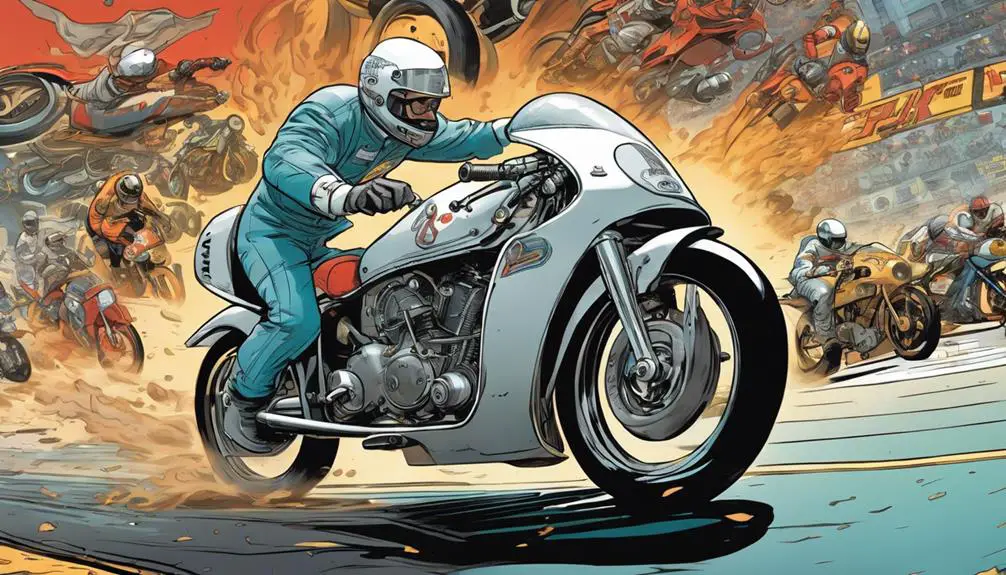
As motorcycle racing has evolved, its cutting-edge technologies have trickled down to everyday bikes, enhancing both performance and safety for riders like you. The innovations born on the racetrack empower your freedom on the road, making every ride exhilarating and secure.
Here's how racing tech impacts your bike:
- Aerodynamics: Streamlined designs reduce drag, allowing you to slice through the wind effortlessly.
- Suspension Systems: Advanced suspension technology, tested on racetracks, absorbs bumps, providing you with a smoother ride and better handling.
- Braking Systems: High-performance brakes, like anti-lock braking systems (ABS), guarantee you have maximum control, especially in tight corners or during sudden stops.
- Engine Management: Racing-derived fuel injection and tuning technologies enhance throttle response, giving you that rush of power at your command.
These advancements not only amplify your bike's capabilities but also ensure your safety.
Embracing these innovations means you can truly experience the open road, liberated and confident. It's about more than just speed; it's about riding with purpose and precision.
Navigating Production and Supply Issues
While racing technology has transformed motorcycle performance, the industry now faces significant production and supply challenges that can impact availability and innovation. You might've noticed the scarcity of certain models or the rising prices of parts. These issues stem from a complex web of global supply chains, disrupted by events like pandemics, trade restrictions, and even natural disasters. As a rider who craves freedom, you want your bike to reflect that spirit, but when manufacturers struggle to source materials or face delays, it hampers your liberty.
Additionally, the shift toward sustainable practices is putting pressure on production methods. You desire cutting-edge technology, yet manufacturers must balance eco-friendly initiatives with the need for speed and agility. This balancing act can slow down innovation and limit choices.
For you, the ideal motorcycle isn't just a machine; it's a symbol of freedom and adventure. To guarantee that dream continues, the industry must navigate these hurdles effectively. By advocating for transparency in supply chains and supporting local production, you can help push the motorcycle community toward a future that embraces both innovation and accessibility.
Your ride should never feel restricted; it should always be about liberation.
Future Engineering Aspirations
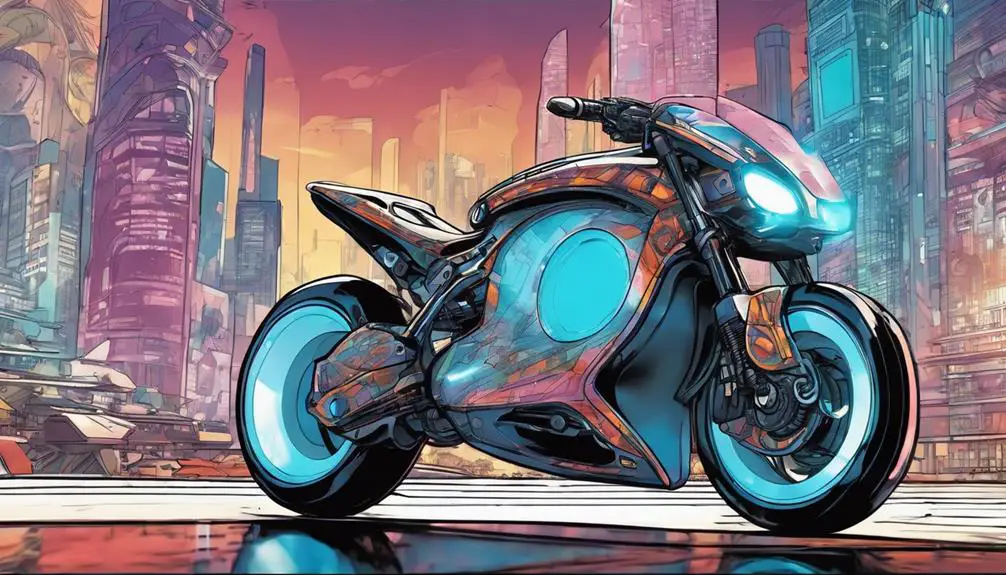
The future of motorcycle engineering holds exciting possibilities, with innovations poised to enhance performance, sustainability, and rider experience.
As you embrace the freedom of the open road, you can look forward to advancements that'll redefine what it means to ride. Here's what's on the horizon:
- Electric Powertrains: Expect more electric motorcycles that offer zero emissions and reduced noise, allowing you to connect with nature without the pollution.
- Advanced Materials: Lightweight, durable materials will improve efficiency and handling, making your ride smoother and more exhilarating.
- Smart Technology: Integration of AI and IoT will usher in features like adaptive cruise control, real-time diagnostics, and enhanced safety systems, giving you peace of mind as you explore.
- Sustainable Manufacturing: Companies are focusing on eco-friendly production methods, ensuring that the bikes you love are built with the planet in mind.
These innovations don't just promise a better ride; they embody a spirit of liberation, letting you experience the thrill of motorcycling in a way that's conscious and responsible.
The road ahead looks bright!
Frequently Asked Questions
What Inspired the First Motorcycle Designs in History?
You'll find that the first motorcycle designs emerged from a desire for freedom and innovation.
Inventors like Gottlieb Daimler and Wilhelm Maybach combined existing technologies, envisioning a faster, more efficient way to travel.
Their passion for speed and mobility inspired them to create machines that offered liberation from traditional transport.
This spirit of adventure and exploration paved the way for the evolution of motorcycles, revolutionizing personal transportation and igniting a lifelong pursuit of the open road.
How Have Motorcycle Safety Standards Evolved Over Time?
Motorcycle safety standards have evolved considerably over time to prioritize rider protection.
You've probably noticed improvements like mandatory helmet laws, enhanced braking systems, and better visibility features. These changes reflect a growing awareness of the dangers motorcyclists face.
As regulations tighten, manufacturers innovate, creating safer designs that empower you to ride with confidence.
The journey toward safer riding experiences continues, ensuring you can enjoy the thrill while minimizing risks.
What Role Do Aerodynamics Play in Motorcycle Design?
Aerodynamics plays an essential role in motorcycle design, enhancing performance and stability.
When you ride, the bike's shape affects how air flows around it, impacting speed and fuel efficiency. A streamlined design reduces drag, allowing you to cut through the wind more smoothly.
You'll notice that better aerodynamics not only improves handling but also contributes to your overall safety.
Which Companies Were Pivotal in Early Motorcycle Innovations?
Think of the thrill you feel while riding; that excitement owes much to early innovators.
Companies like Harley-Davidson, Indian, and Triumph were pivotal in motorcycle innovations. They pushed boundaries and set the stage for modern biking, creating powerful engines and reliable designs.
Their passion for freedom on two wheels inspired generations to embrace the open road.
Without their groundbreaking contributions, today's motorcycle culture wouldn't be what it is.
How Do Motorcycle Engineering Challenges Differ From Those in Cars?
When you immerse yourself in motorcycle engineering, you'll notice it's all about weight and agility.
Unlike cars, motorcycles need to balance power and handling without the luxury of extra space. You're dealing with a smaller frame, so every ounce counts.
Plus, the focus on aerodynamic design is essential for stability at high speeds.
While cars often emphasize safety features and comfort, motorcycles prioritize performance and maneuverability, giving you that exhilarating sense of freedom.
Conclusion
To summarize, the engineering challenges that have shaped motorcycle history are like the twists in a winding road—each turn leads to new innovations and improvements.
As you ride into the future, remember that the quest for performance, sustainability, and cutting-edge technology continues to drive the industry forward.
Embracing these challenges will guarantee that motorcycles not only evolve but also thrill riders for generations to come.
Keep your eyes open; the journey has only just begun.